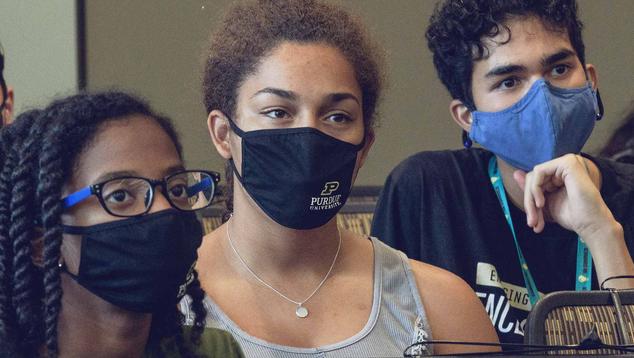Story Highlights
- Purdue is a Don Clifton Strengths for Students Award winner for 2020
- The university integrates strengths throughout the student experience
- Using five pillars, it takes a holistic approach to student wellbeing
The Don Clifton Strengths for Students Award recognizes institutions doing exceptional work in integrating CliftonStrengths for Students across their districts and campuses.
Impact, Well-Being, Grit: These learning pillars were key focuses for Purdue University before COVID-19 and have only become more vital during the pandemic. Purdue was nominated for the Don Clifton Strengths for Students Award even before the disruption began, but its work to integrate strengths throughout the student experience has positioned the university to continue to support students, encourage self-understanding, and fulfill the institution's mission to prepare students for success in their studies and beyond.
Developing the Leaders of Tomorrow
When Vice Provost for Student Life Beth McCuskey joined Purdue University in 2010, she was on the lookout for a way to bring CliftonStrengths for Students to campus. The opportunity came, thanks to a generous donation from alum Roger C. Stewart, which allowed for the creation of the Leadership and Professional Development Initiative (LPDI) -- a campus-wide framework to intentionally develop students' leadership and professional development knowledge and skills by connecting classroom learning to out-of-class experiences.
As part of this initiative, the Roger C. Stewart Leadership Experience at Purdue (LEAP) program offers all incoming undergraduate students an opportunity to take the CliftonStrengths assessment and learn more about their natural talents, aligning with one of Purdue's key competencies: self-understanding. The program also encourages reflection to help students translate what they learn about themselves into their next steps after school.
What Generation Z Needs to Thrive
LPDI provides the self-understanding and reflective bookends for another recently launched program called Steps to Leaps. Its purpose is to support student character and wellbeing with resources grounded in what Gen Z students expect from their educational experience. It consists of five pillars: Well-Being, Leadership and Professional Development, Impact, Networks, and Grit.
"We're trying to take a holistic approach, focusing on wellbeing overall -- body, brain, spirit," McCuskey explained.
The Professional Development pillar connects to the Gen Z tendency to be more focused on finding close connections between experiences in the classroom and those outside it, and wanting to have a direction right out of the gate.
"Our Leadership and Professional Development Initiative is part of this as well in developing those skills that students can learn in college and really perpetuate throughout their careers," McCuskey said.
The Impact pillar relates to another Gen Z trait -- a focus on making a difference in the world. "The flip side of that is sometimes that becomes stressful," McCuskey said. "So we try to help students see the potential for big impact and fostering those dreams but also looking at how every day has the potential for an impact."
"We try to help students see the potential for big impact and fostering those dreams but also looking at how every day has the potential for an impact."
The Networks pillar focuses on helping students discern how they interconnect on a deeper level.
"It's not just building a network for the purpose of taking, but also giving to your network," McCuskey said. "People who have closer ties in a physiological as well as sociological sense have a much stronger resilience than those who are loosely connected."
The last pillar, Grit, is defined in terms of bounce back -- are students learning from failure and picking themselves back up?
"We're helping them understand what skills they need to approach failure while supporting risk-taking and innovation," McCuskey explained. "Failure is a necessary component of that. If you're pushing yourself out there, you're not going to win every time."
Purdue integrates CliftonStrengths across these pillars as the foundational sense of self that informs the school's individualized approach to wellbeing and resiliency.
"We will get students all the time who come back from job interviews and say, 'They asked me what my strengths were,' and they went back to their Gallup strengths and were able to articulate, 'This is who I am, this is how that manifests for me, and this is how I approach and overcome challenges,'" McCuskey said.
Understanding Yourself by Understanding Your Strengths
Because of Purdue's large size, each college has a lot of autonomy with its curriculum and first-year seminars -- and even though it's elective, many are incorporating strengths. McCuskey attributes this to the effectiveness of Purdue's programs. "The fact that it's snowballing and people are using it shows the impact people see in their respective areas," she said.
Katie Lyon, Gallup Education's Managing Director, notes that such thinking is how schools create a sustainable strategy.
"Ironically, our most successful campuses aren't aiming to become a strengths-based campus," Lyon said. "Rather, their goal is to become a thriving, engaged campus using strengths as a means to support wellbeing. Purdue has done just that. Their strategy is woven into multiple touchpoints across campus, and campus leaders have the autonomy to decide how they enhance preexisting programs with intentional strengths conversations around wellbeing. Ultimately, this creates greater buy-in and commitment across the entire campus."
Whether students experience a CliftonStrengths touchpoint in their pre-orientation homework, in an advising session, in a residence hall, in a strengths-based learning event or even during a strengths coaching session in the Dean of Students office, there are countless ways for them to discover who they are, what they do best and how they can achieve their goals.
As McCuskey put it, "Strengths are one of those things -- our students would know about them if you asked them because they've seen them applied in so many different places. They get it. It's part of the culture. It's part of Purdue."
Read more about focusing on what's strong with students:
- Meet the other winners of the Don Clifton Strengths for Students Award.
- Learn more about CliftonStrengths for Students.
- Subscribe to the Gallup Education Insights Newsletter to get the latest advice and research on how to develop engaged and thriving campuses using a strengths-based approach.





